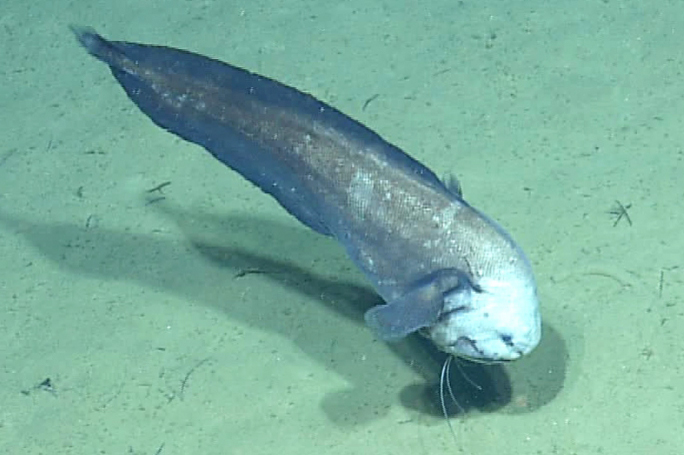Gargoyle Cusk, Acanthonus myersi (Cohen 1961)

A Gargoyle Cusk, Acanthonus myersi, in Mona Slide, Caribbean, depth 1888 m. Source: Ocean Exploration Trust / WORMS. License: CC by Attribution-NonCommercial-ShareAlike
A rare brownish deep-sea cusk with pale brown fin margins, and dark jaws, pelvic fins, mouth, gill cavities and peritoneum. Adults have a huge head with prominent spines on the opercle and preopercle bones.
This species was previously known as Xyelacyba myersi.
Gargoyle Cusk, Acanthonus myersi (Cohen 1961)
More Info
|
Distribution |
Off North West Cape, Western Australia, in 1100-1150m. Elsewhere, the species is circumglobal on the continental slope of tropical and subtropical seas, except the eastern Pacific. |
|
Features |
Dorsal fin 7-89; Anal fin 70-74; Pelvic fin 2; Pectoral fin 18-20; Caudal fin 9; Gill rakers ~16. Body strongly compressed, head very large; snout short, rounded, no spine on snout tip; eyes small. Opercle and preopercle each with a prominent grooved spine projecting to or beyond the rear margin of the head, additional smaller spines at lower angle of preopercle. Pelvic fins relatively close together, each with 2 rays (Fig. 26a); position variable, inserted between the level of the orbit and the rear of the maxillary. |
|
Colour |
Whitish overall, margins of median fins light brown; jaws, pelvic fins, mouth and gill cavities deep brown; peritoneum and stomach deep brown. |
|
Feeding |
Feeds mostly on fishes and crustaceans. |
|
Biology |
Reproductive strategy unknown - presumably oviparous with pelagic eggs in a gelatinous mass - like other members of the family. |
|
Conservation |
|
|
Etymology |
The species is named in honour of George S. Myers of Stanford University. |
|
Species Citation |
Xyelacyba myersi Cohen, 1961, Copeia 1961(3): 289, fig. 1. Type locality: Gulf of Mexico, 27°48'N, 88°45'W, Oregon station 2577, depth 850-1100 fathoms. |
|
Author |
Bray, D.J. 2024 |
|
Resources |
Gargoyle Cusk, Acanthonus myersi (Cohen 1961)
References
Cobián Rojas, D., Espinosa-Perez, H., Polanco Fernandez, A. & Vega-Cendejas, M. 2019. Xyelacyba myersi. The IUCN Red List of Threatened Species 2019: e.T135401118A135579162. https://dx.doi.org/10.2305/IUCN.UK.2019-2.RLTS.T135401118A135579162.en. Accessed on 27 July 2024.
Cohen, D.M. 1961. A new genus and species of deepwater ophidioid fish from the Gulf of Mexico. Copeia 1961(3): 288-292. https://doi.org/10.2307/1439802
Cohen, D.M. & Nielsen, J.G. 1978. Guide to the identification of genera of the fish order Ophidiiformes with a tentative classification of the order. National Marine Fisheries Service (U.S.). Technical Report 417: 1-72 figs 1-103, https://doi.org/10.5962/bhl.title.63242 (as Xyelacyba myersi)
Girard, M.G., Nonaka, A., Baldwin, C.C. & Johnson, G.D. 2024. Discovery and description of elaborate larval cusk-eels and the relationships among Acanthonus, Tauredophidium, and Xyelacyba (Teleostei: Ophidiidae). NOAA Professional Paper NMFS 24: 20-42 https://doi.org/10.7755/PP.24.3
Machida. Y. 1989. First record of the deep-sea fish Xyelacyba myersi (Ophidiidae, Ophidiiformes) from Japan. Japanese Journal of Ichthyology 36(1): 120-125.
Mincarone, M., Nielsen, J. & Costa, P. 2008. Deep-sea ophidiiform fishes collected on the Brazilian continental slope, between 11° and 23°S. Zootaxa 1770: 41-64. https://doi.org/10.11646/zootaxa.1770.1.2
Nielsen, J.G., Cohen, D.M., Markle, D.F. & Robins, C.R. 1999. Ophidiiform Fishes of the World. An annotated and illustrated catalogue of pearlfishes, cusk-eels, brotulas and other ophidiiform species known to date. FAO Fisheries Synopsis No. 125 Vol. 18. 178 pp. (as Xyelacyba myersi)
Nielsen. J.G. 1999. Families Carapidae, Ophidiidae, Bythitidae, Aphionidae. pp. 1978-1985 in Carpenter, K.E. & Niem, V.H. (eds). The Living Marine Resources of the Western Central Pacific. FAO Species Identification Guide for Fisheries Purposes. Rome : FAO Vol. 3 1397-2068 pp. (as Xyelacyba myersi)
Quattrini, Andrea & Demopoulos, Amanda & Singer, Randal & Roa-Varon, Adela & Chaytor, Jason. (2017). Demersal fish assemblages on seamounts and other rugged features in the northeastern Caribbean. Deep Sea Research Part I: Oceanographic Research Papers 123. https://doi.org/10.1016/j.dsr.2017.03.009
Williams, A., Last, P.R., Gomon, M.F. & Paxton, J.R. 1996. Species composition and checklist of the demersal ichthyofauna of the continental slope off Western Australia (20–35º). Records of the Western Australian Museum 18: 135-155. (as Xyelacyba myersi)




